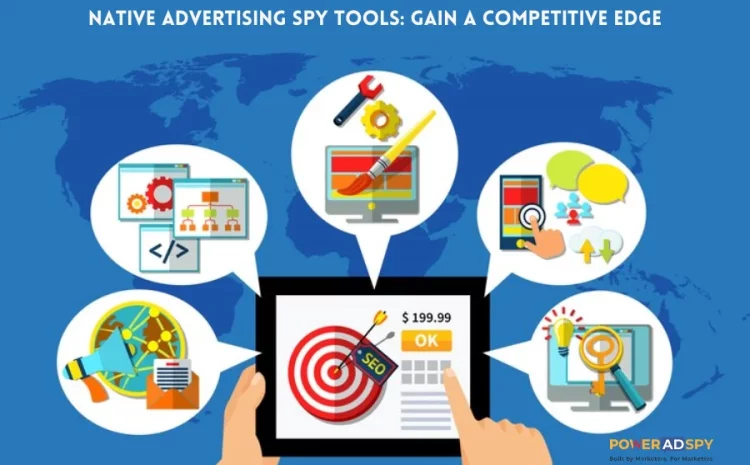To spy on native ads competitors, use competitive analysis tools and monitor their ad placements and content strategies. Track their performance metrics for insights.
Spying on native ads competitors can provide valuable insights into their marketing strategies. By understanding what works for them, you can enhance your own campaigns. Start by using competitive analysis tools like Adbeat, SEMrush, or SpyFu. These tools help you uncover ad placements, creatives, and performance metrics.
Analyzing competitors’ successful ads can inspire new ideas and improve your ad performance. Regularly monitor their content and adapt your strategies to stay ahead. This approach not only boosts your ad effectiveness but also helps in staying competitive in the dynamic digital advertising landscape.
Introduction To Native Ads Spying
Understanding what your competitors are doing is crucial. It helps you learn their strategies. You can see what works for them. This knowledge can improve your own ads. It saves you time and money. Knowing your competitors also helps you stay ahead in the game.
Native ads blend into the content of a site. They look like regular posts or articles. This makes them less intrusive. Users often engage more with native ads. They are effective in grabbing attention. Native ads can increase your brand awareness. They can lead to higher conversion rates.
Choosing The Right Tools For Spying
Free tools are great for beginners. They help you save money. But, they often lack advanced features. Paid tools offer more features. They give detailed insights and better results. Costs might be high, but worth it for serious marketers.
| Tool Name | Type | Features |
|---|---|---|
| AdPlexity | Paid | Detailed insights and competitor analysis |
| SpyFu | Paid | Search and ad analytics |
| Anstrex | Paid | Competitive intelligence and ad insights |
| Moat | Free | Basic ad tracking |
Analyzing Competitor’s Native Ads Strategy
First, find out who your competitors are targeting. Look at their ad placements and engagement metrics. Use tools like SimilarWeb to gather demographic data. Notice the age, gender, and interests of their audience. This helps in understanding their target market. Once you know their audience, you can plan better. Focus on similar groups to achieve success.
Examine the creative elements of competitor ads. Notice the headline and call-to-action phrases they use. Observe the images and videos that get the most engagement. This tells you what works best. Look at the color schemes and fonts they use. These details can make a big difference. Replicate what works but add your own twist. This way, your ads will stand out.

Credit: poweradspy.com
Learning From Competitor’s Ad Placement
Facebook and Twitter are popular platforms for native ads. Instagram also offers great potential for native advertising. LinkedIn is another platform where many businesses place native ads. Each platform has its own unique audience. It’s important to study these platforms closely. This helps in understanding where to place your ads.
Look at where your competitors place their ads. Analyze the types of content they use. Check if they use images or videos. Look at the placement within the platform. Are the ads at the top or bottom of the feed? This helps you learn what works best. Always keep an eye on your competitors’ strategies. It gives valuable insights for your own ad campaigns.
Adapting And Innovating Your Strategy
Study the most successful ads of your competitors. Identify the key elements that make these ads work. Use these elements to enhance your own ads. Always look for patterns in the top-performing ads. This can help you understand what works. Use similar strategies to improve your ad campaigns. Make sure to add your unique twist to stand out. This way, you can stay ahead of the competition.
Identify common mistakes made by your competitors. Learn from these mistakes to avoid them in your campaigns. This can save you time and resources. Look at poorly performing ads to see what went wrong. Avoid using similar ineffective strategies. This helps you create better ads. Focus on what not to do just as much as on what to do. This can lead to more effective ads and higher engagement.

Credit: poweradspy.com
Staying Ahead In The Native Ads Game
Track your competitors’ ads daily. Analyze their ad copy and design. Note what works well for them. Study their ad placement. Check their landing pages. Evaluate their success. Adjust your strategy based on your findings. Use tools like Adbeat or WhatRunsWhere. Identify patterns in their campaigns. Keep an eye on their changes.
Stay updated with the latest trends. Adopt new technologies. Experiment with innovative ad formats. Learn from industry leaders. Attend webinars and conferences. Read industry blogs and reports. Implement best practices. Optimize your ads continuously. Test different strategies. Evolve with the market.

Credit: www.youtube.com
Frequently Asked Questions
How To Spy On Competitors Ads?
Use tools like SEMrush, AdSpy, or Facebook Ad Library. Analyze competitor ads for keywords, visuals, and copy.
How To See Competitor Display Ads?
Use tools like SEMrush, AdSpy, or Moat to view competitor display ads. Check their social media and website for insights.
How Do I Track Native Ads?
Use tracking pixels and UTM parameters to monitor native ads. Leverage analytics tools like Google Analytics for detailed insights. Use dedicated native ad platforms for better tracking and reporting. Regularly review performance metrics to optimize campaigns.
How Can You Determine If Something You See Is Native Advertising?
Native advertising often looks like regular content but includes a disclosure like “Sponsored” or “Ad. ” Check for subtle branding and promotional tone.
Conclusion
Mastering the art of spying on native ads competitors is essential. Utilize tools, analyze strategies, and adapt effectively. Stay ahead by continuously monitoring and refining your approach. Your efforts will pay off with improved ad performance and market insight. Keep learning and evolving to maintain a competitive edge.
